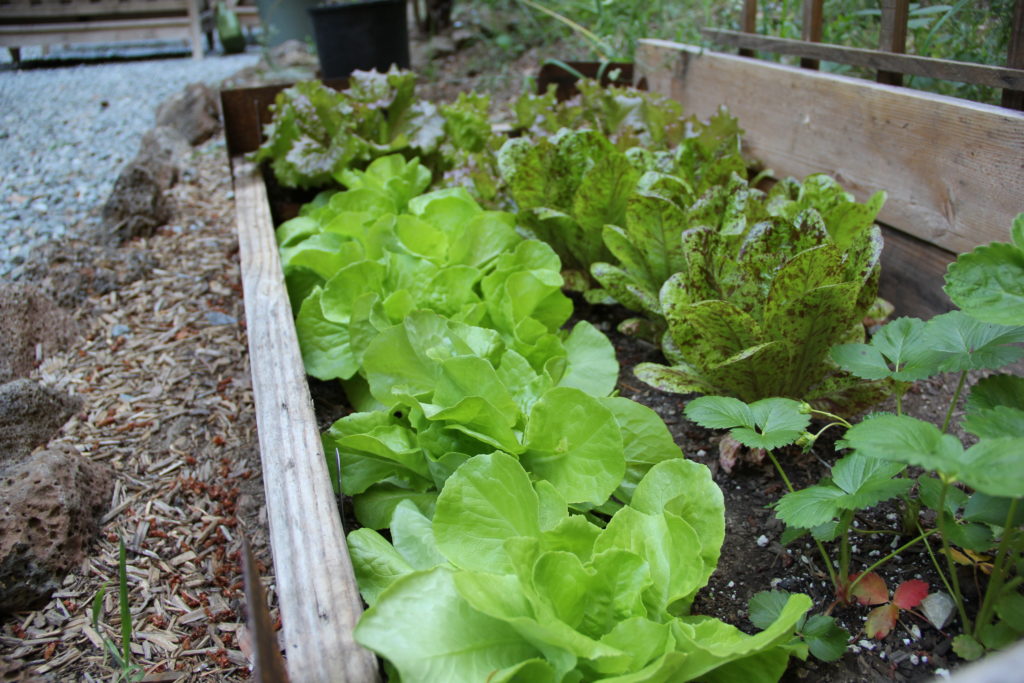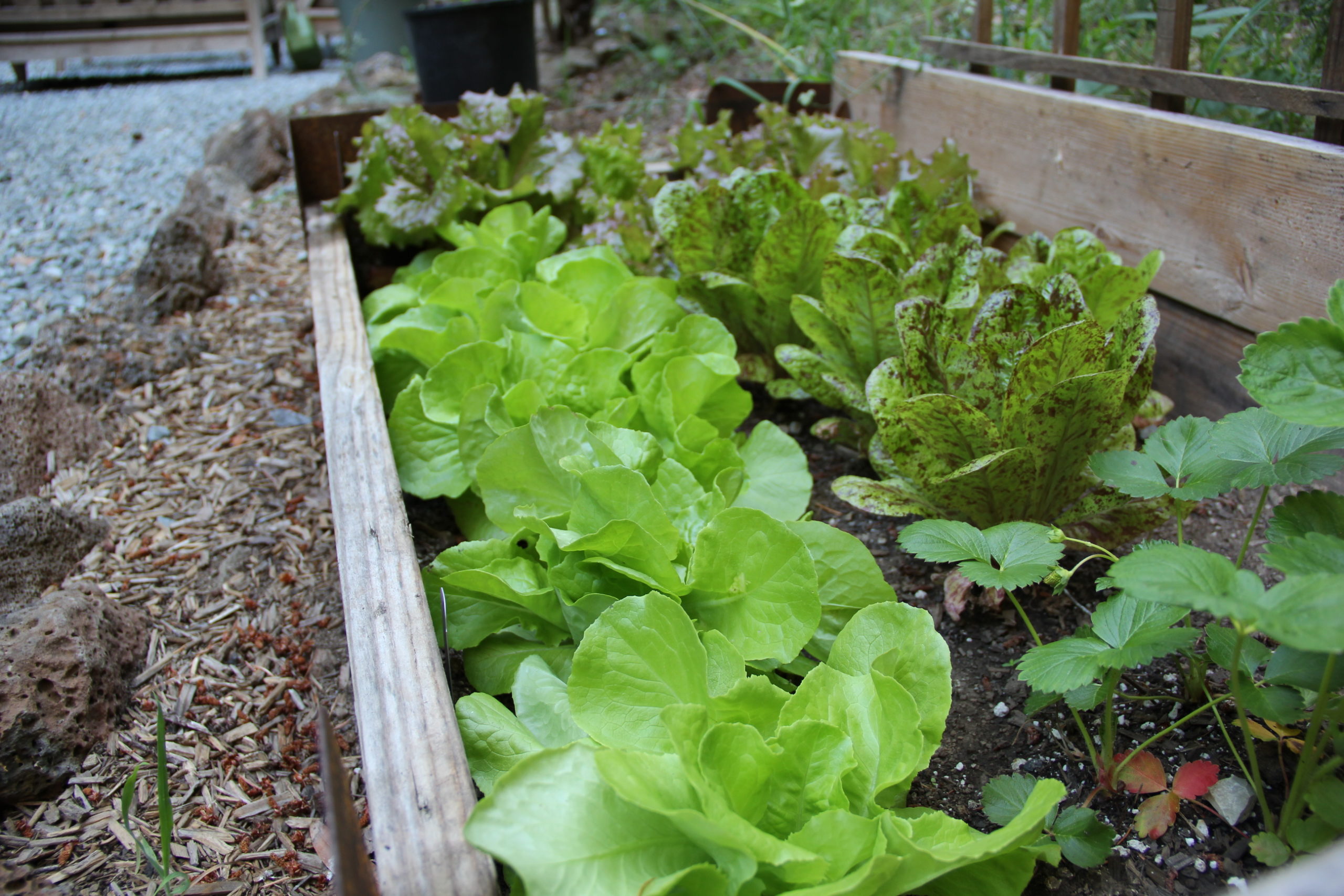By Guest Blogger: Emily Hatfield, of Humanature Landscape Design

It’s spring! It’s spring!
If you’re not already converted to growing a few edible things at home, you will be tempted during this most promising of seasons.
How to begin? If you are working with a small space, perhaps just with a few pots that get decent sunshine, a novice gardener can still have a lot of fun growing veggies and herbs.
There aren’t too many questions that a visit to your local nursery won’t be able to answer, but there are a few tried and true ways to make the most of a small space.
1. Grow Big Ticket Items
Grow the ‘big ticket items’ that are best fresh and local: tomatoes, basil, arugula, salad greens, peas, cucumbers, patty pan summer squash, bush beans, and any herbs you use a lot.
These are my top recommendations for someone with sunshine (at least 5-6 hrs a day). You’ll notice on tags for seedlings and on the back of seed packets are specific instructions on spacing for the plants, hours of sun needed, and days to maturation (meaning how long until you get to eat them!).
2. If You’ve Got Shade
If you are dealing with a shadier spot, stick with greens: kale, chard, mesclun mix, chives.
Buy the heirloom tomatoes at the farmer’s market, or if you’re in a new home and you’re not sure what will grow, try a cherry tomato first, as they have a shorter maturation period (look for ones in between 50-65 days).
A good local nursery can recommend varieties that grow more reliably in the cooler climate & fog belt towns.
3. Prepare Your Soil
Amend the soil first and foremost!!
If you are working with a raised bed or a galvanized trough or a wine barrel, you can really have nice, deep potting soil.
If you are working with native soil, you’ll want to dig down at least a foot, potentially 2’ with added compost (chicken manure, earthworm castings, & leaf mold are all a plus).
Go organic and dig them in one weekend, water the soil well every couple of days for the next week, and then you’ll be ready to plant the following weekend.
4. Seeds versus Seedlings
Best from seed: radishes, carrots, beets, peas, beans (bush), cucumbers, squash (both winter and summer), spinach, arugula and mesclun mix. You can often find weirder, more wonderful varieties of seeds than you can with seedlings.
Organic seedlings from a nursery: tomatoes, eggplants, peppers (hot and sweet), head lettuce, chard, kale.
5. What Not to Plant
Veggies not well-suited to a small garden: broccoli, cauliflower, corn, pole beans, onions, garlic. They take up a bunch of space for the duration of the growing season for not very much payoff.
Though it’s arguable that harvesting your own home-grown broccoli is better than buying at a grocery store, it’s hard to tell the difference taste-wise!
6. Herbs
Herbs (except for basil) are mostly perennials and can be planted amongst your other garden beds, since they require less delicious soil.
My favs for a small garden or in pots: thyme, rosemary, french sorrel, white sage (for tea), and chives.
Mint & oregano need to be grown in a pot or they will take over your garden.
7. Watering
Any veggies planted by seed will need to be watered daily (sometimes twice daily if it’s hot).
If you aren’t able to water by hand, check into setting up a simple, battery powered irrigation controller off a nearby hose bib.
Even with reliable drip irrigation, you will want to water seeds sown by hand to get them to germinate. Once a seed dries out during germination, it doesn’t rebound, so expect to hand water for the first two weeks and then switch on the irrigation. Daily at first and then every other day, depending on your sun and soil.
An exception…tomatoes get more delicious if they’re not over-watered once they start to set fruit. The plants may look a little crusty, but as long as the roots have really established themselves, the fruit will have better texture and flavor.
8. Fruit Trees
If you have slightly more space and are maybe into your second or third year of ‘growing your own’, there are suitable dwarf varieties of apples, plums and pears that grow well in the SF bay area.
I’m a huge fan of evergreen blueberries, as they can be grown in a pot, are pretty plants, and are wonderful grazing foods for kids and adults.
Bonus: Get Your Kids Involved
If you are a first-time gardener and trying to get the kids interested in nature and being invested in a project outdoors, a small edible garden is totally rewarding.
Try sowing things that are quick to mature and from seeds that are big and easy for small hands to manipulate: like radishes, nasturtiums (edible flowers), squash, cucumbers, beans, or peas.
Kids love to water, more than any other gardening activity. Just guide their, um, efforts, in a productive way by investing in a gentle watering device like a watering can that they have to take the time to refill and carry. Or a nice Dramm hose-end sprayer that creates a gentle shower for new shoots and seedlings.
Check out “Roots, Shoots, Buckets & Boots”, a book that has great activities for involving little ones in the garden.
Don’t Be Afraid To Try!
No matter the size or location there is generally something you can grow. The important step is to try!
The reward of harvesting and enjoying your home-grown food is like nothing else.
